The total value of EU imports of wood products was Euro 17.48 billion in 2016, 1.3% more than in 2015. This followed an increase of 12% to Euro 17.25 billion in 2015. In 2016 EU import value was at the highest level since 2008 just before the global financial crises (Chart 1).
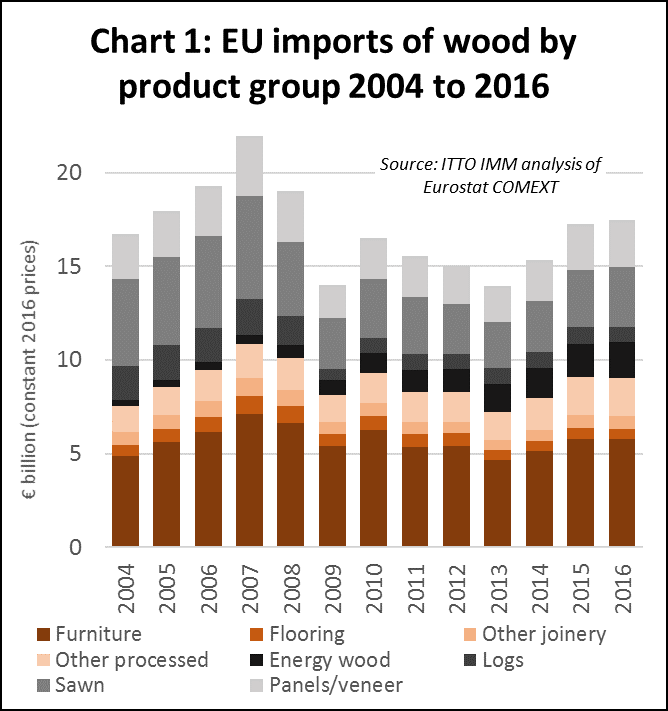
The value of the euro plunged 20% against the U.S. dollar between 2014 and 2015, resulting in a sharp increase in euro import prices at that time, particularly for goods from North America and Asia. This was a major factor boosting the value of EU imports in 2015. However, the value of the euro remained relatively stable against the U.S. dollar between 2015 and 2016 and had much less impact on the import value trend last year.
Considering individual products (Chart 2), the value of EU imports of wood furniture fell by 0.3% to Euro 5.78 billion in 2016 after a sharp increase in 2015. This was mainly due to a decline in EU imports from China. EU imports of wood furniture from non-EU countries in Europe were rising last year. This forms part of general trend of increasing EU dependence on wood furniture manufactured in central and Eastern Europe.
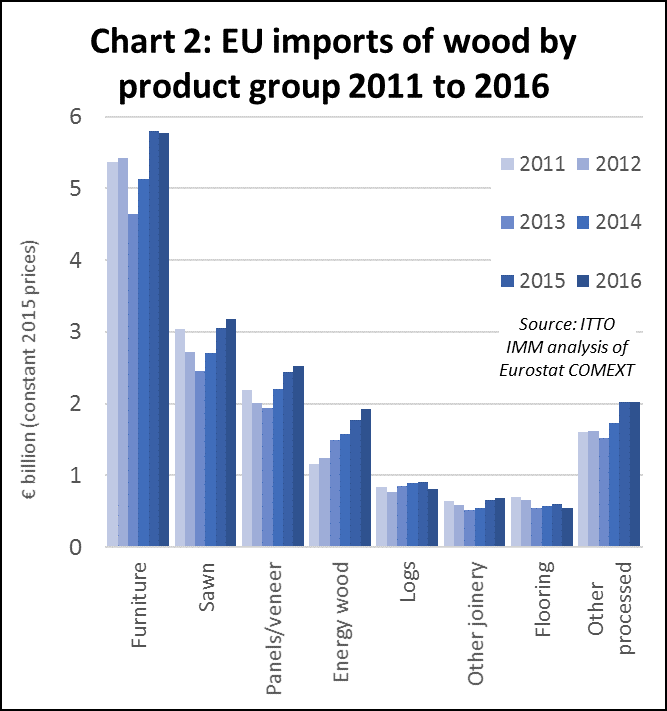
The value of EU imports of sawn wood increased 4.3% to Euro 3.2 billion last year, continuing the rising trend which began in 2013. There was a particularly significant increase in the value of EU sawn wood imports from Africa in 2016 which offset a sharp decline in imports from South East Asia. EU imports of sawn wood from Russia and other CIS countries also continued to rise last year, helped along by the relative weakness of currencies in the region.
EU imports of panels (mainly plywood) increased 3.1% to Euro 2.52 billion in 2016 following an 11% in 2015. A significant increase in plywood imports from Russia offset declining imports from China and Latin America. There were also gains in EU plywood imports from Africa in 2016.
The long-term rise in EU imports of energy wood continued in 2016 to reach an all-time high of Euro 1.93 billion, up 9% compared to the previous year and nearly four times the value of a decade ago. EU imports of energy wood (now dominated by pellets) increased sharply from the U.S. and CIS region last year.
Following a 22% increase in 2015, EU imports of other joinery products (mainly doors and LVL for window frames) increased a further 4% to Euro 690 million in 2016. Significant gains were made by Indonesia, Malaysia, Russia and Ukraine in supply of joinery products to the EU last year, while imports from China lost ground (although China is still the single largest external supplier).
EU imports of wood flooring fell back 9% to Euro 540 million in 2016, mainly due to a 11% decline in imports from China to Euro 341 million. EU imports of “other processed products” (mainly classified under HS 442190 and not separately identified) remained stable at Euro 2.02 billion after a 17% gain in 2015. 56% of EU imports of “other processed products” derive from China.
The value of EU imports of wood products from tropical countries decreased 0.8% to Euro 3.79 billion in 2016, reversing the rising trend of 2014 (+6.1%) and 2015 (+15.3%). The share of tropical countries in the total value of EU wood product imports has remained stable at around 22% in the last 3 years. The declining share of tropical countries in total EU imports experienced in the decade prior to 2014 has halted for now (Chart 3).
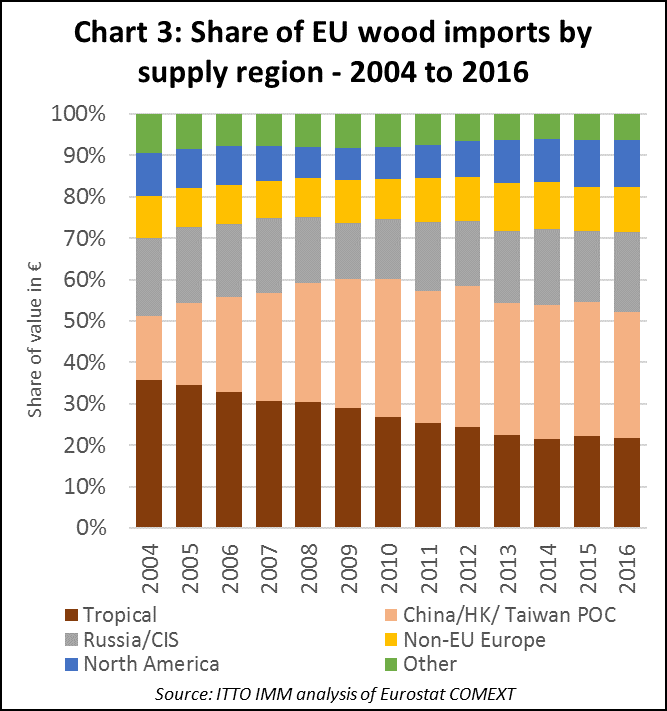
China’s share in total EU imports of wood products fell from 32.4% in 2015 to 30.5% last year, while the share of Russia and other CIS countries increased from 17.2% to 19.3%. In 2016, there was a slight increase in share of EU imports from non-EU European countries (from 10.5% to 10.8%) and North America (from 11.4% to 11.5%).
The slight decline in the total value of EU wood product imports from the tropics in 2016 hides variations between products groups (Chart 4). Last year, there was a decline in EU imports from tropical countries of wood furniture (-2.2% to Euro 1.52 billion), sawn wood and decking (-1.9% to Euro 1.01 billion), energy wood (-2.9% to Euro 138.9 million), flooring (-20.3% to Euro 76.4 million), and logs (-4.2% to Euro 73.8 million). However, these declines were partly offset by rising EU imports from tropical countries of plywood and veneer (+9.5% to Euro 44.4 million) and other joinery (+3.2% to Euro 263 million – mainly LVL and doors).
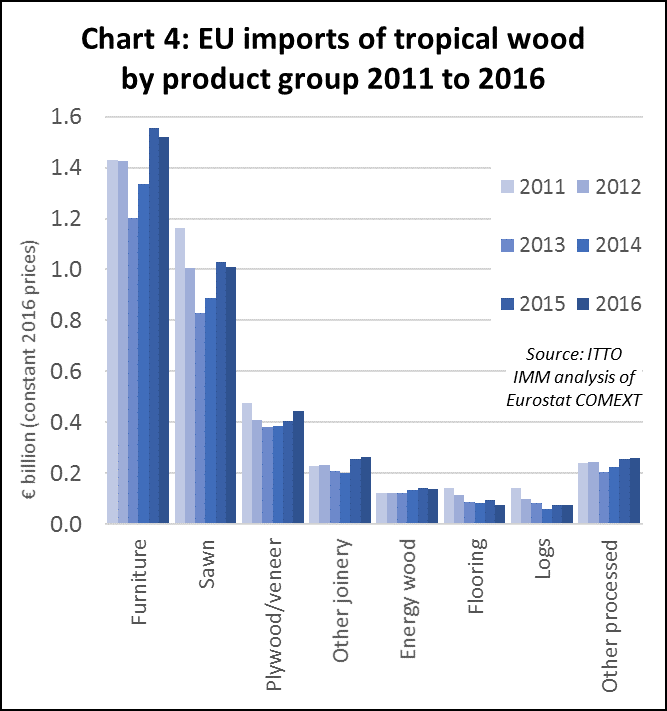
EU wood products exports just short of record level last year
In 2016, the EU exported wood products with a total value of Euro 20.40 billion, just short of the previous year’s record level of Euro 20.51 billion (Chart 5). The EU’s wood product trade surplus with the rest of the world fell from Euro 3.26 billion in 2015 to Euro 2.92 billion in 2016. This was mainly due to a 1.7% decline in EU exports of wood furniture to Euro 8.60 billion in 2016, and an 8.6% decline in exports of energy wood, to Euro 176 million.
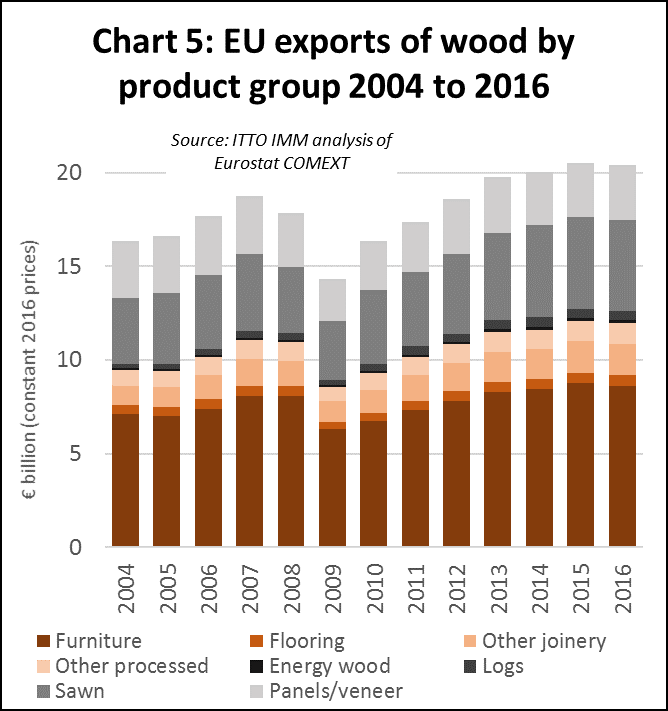
Italian wood machinery sales give cause for optimism
The wood market in Italy has been depressed now for several years. However newly released data on wood machinery sales suggests there was a significant upturn in capital investment in the industry last year.
Data from Acimall, the Italian association of woodworking machinery manufacturers, show that total sales by members to domestic industry were Euro 592 million in 2016, 31.6% more than the previous year. Export sales of woodworking machinery also increased in 2016, but at a slower rate of 5.1% to Euro 1486 million. Much of the recent growth in export sales has been concentrated in North America. Acimall suggest that increase in sales last year was driven both by public incentives and measures to support industrial activity and by rising wood product consumption.
Taken together, the data shows that Italian machinery manufacturers’ total sales increased by 11.5% to Euro 2078 million in 2016. This is close to the industry’s record production level of Euro 2159 million in 2007.
New EU ecolabel criteria for wood flooring
On 25 January 2017, the EU published Decision (EU) 2017/176 in the official EU Journal establishing EU Ecolabel criteria for wood, cork and bamboo based floor coverings. The new criteria require that any virgin wood, cork, bamboo and rattan in the finished products originates from certified sustainably managed forests.
In addition, the Ecolabel criteria include a set of measures to ensure low energy consumption for manufacturing, drastically limit the VOC (Volatile Organic Compound) content, and ban use of harmful chemicals for flame retardant, binding and finishing applications.
The EU Ecolabel is a voluntary scheme, which means that producers, importers and retailers can choose to apply for the label for their products. While not mandatory for the specified product, the green procurement policies of many EU authorities now recognize and may give preference to products bearing the EU Ecolabel.
A copy of the Decision on the wood flooring Ecolabel in all European official languages is available at: http://eur-lex.europa.eu/legal-content/EN/TXT/?qid=1486024464540&uri=CELEX:32017D0176
ATIBT publish new guide to using African timbers in Europe
The Association Technique Internationale des Bois Tropicaux (ATIBT – International Tropical Timber Technical Association) has just released an important new publication, Volume 1 of their “User Guide for Eco-certified African Timber in Europe”. The aim is to help transform attitudes to tropical timber in Europe, enhancing awareness that it offers an efficient, technically superior and responsible material for use in a wide range of applications.
The ATIBT Guide shows how certified African species can supplement and complement temperate timber species, thereby helping to expand the total market for wood products in Europe. To achieve these goals the guide promotes both the natural properties of tropical timber and the major effort to independently certify and legally verify forests in tropical Africa.
The ATIBT Guide was prepared by Patrick Martin and Michel Vernay, both qualified timber engineers and recognized experts in the use of tropical timber in construction, with financial support from the PPECF (Programme de Promotion de l’Exploitation Certifiée des Forêts – Programme for the Promotion of Certified Forest Operations) and the AFD (Agence Française de Développement – French Development Agency).
Volume 1 of the Guide is intended for European users of African timber, as well as all suppliers, distributors, designers, public prescribers and instructors whose activities are linked to the timber sector. Volume 2, yet to be published, will target African consumers.
The Guide is divided into two sections. The first section provides technical information on the various aspects of tropical timber. It explains in layman’s terms the principles of sustainable tropical forestry and its implications for land-use change, carbon sequestration and other environmental impacts, and describes the African production region, progress to achieve certification and it’s implications and benefits.
The first section also explains the various technical properties of tropical timbers (mechanical resistance, hardness, resilience, aesthetics, durability), provides information on drying and other treatments and appropriate applications, and thereby highlights the benefits of using tropical timber in construction.
The second section of the Guide describes the wide range of applications for which tropical timber offers clear technical, aesthetic and environmental advantages, including exterior and interior joinery applications, water-protection and other heavy duty structural and industrial applications, boat-building, and high value items like musical instruments and turnery products. For each application, the guide provides information on the required properties of timbers, relevant standards, and a list of appropriate tropical timber species.
To download a pdf of the Guide and for details of how to order paper versions go to:
https://www.atibt.org/en/eco-certified-african-timber-user-guide-has-been-released/
International conference on hardwood processing
The ISCHP – International Scientific Conference on Hardwood Processing – has issued an invitation and general call for abstracts to the 6th edition of their event to be held in Lahti, Finland from September 25th to 28th, 2017. The conference continues the series of ISCHP conferences which were previously held in Canada (2007), France (2009), USA (2011), Italy (2013) and Canada (2015).
The main objective of the conference is to bring together the scientific and research communities working on hardwoods from the source to the customer, to share knowledge, experience and ideas. International experts, scientists, government employees, hardwood industry representatives, suppliers and customers are invited to discuss recent progress and innovative work in this valuable area.
The Organizing Committee of the conference has invited participants to propose contributions and submit abstracts on the following topics:
- Hardwood Quality, Forest Management and Wood Procurement
- Hardwood Properties and Analysis of Raw Materials
- Hardwood Processing, Optimization and Technology Development for Wood and Composite products
- Hardwood Biorefining and Value-added Chemical Products
- Hardwood Product Development and Performance
- Markets, Sustainability and Value Chains of Hardwood Cluster.
More details of the conference are available from Erkki Verkasalo (Luke) at Natural Resources Institute Finland (Tel : +358 29 532 3020, http://www.ischp2017.org).
PDF of this article:
Copyright ITTO 2020 – All rights reserved

